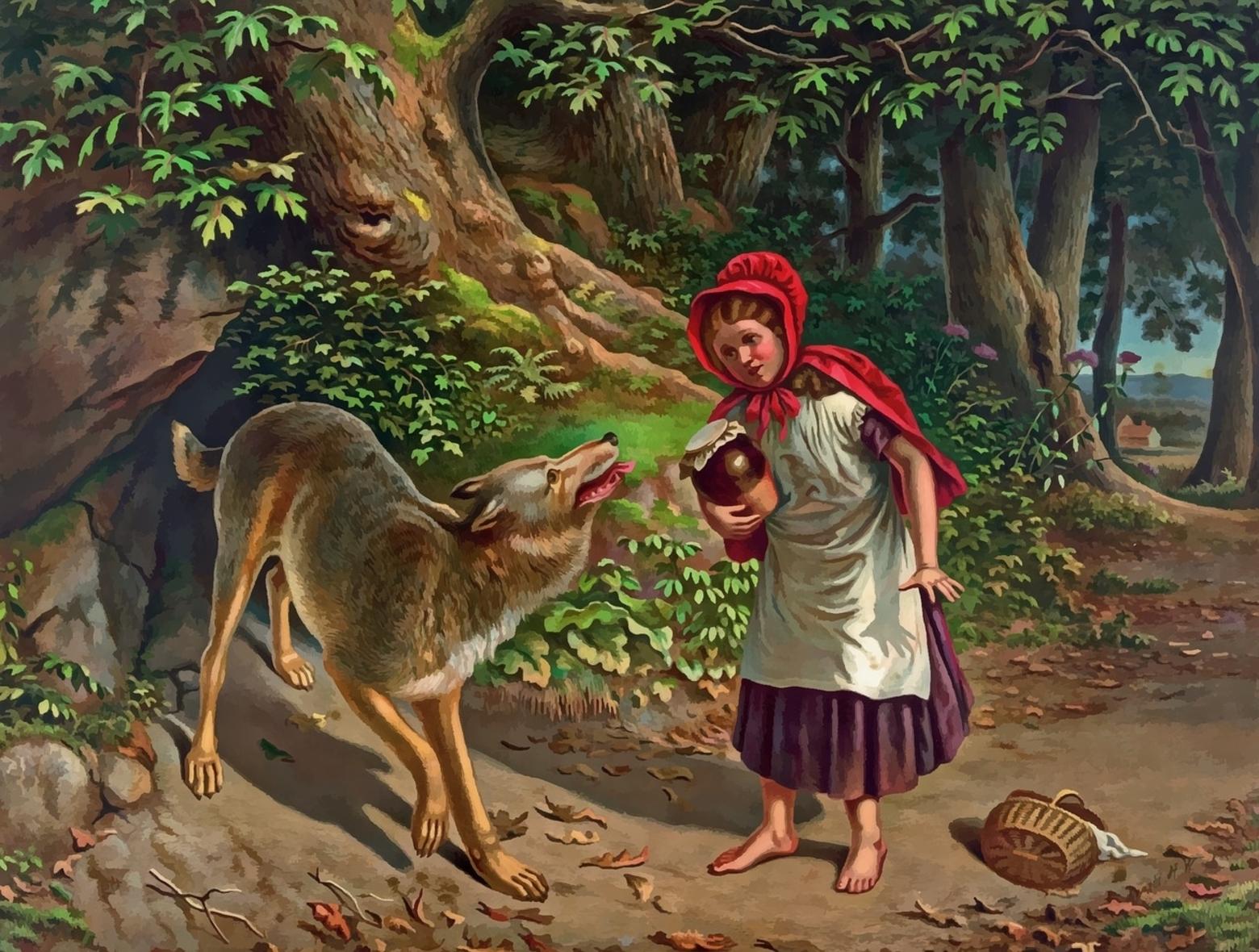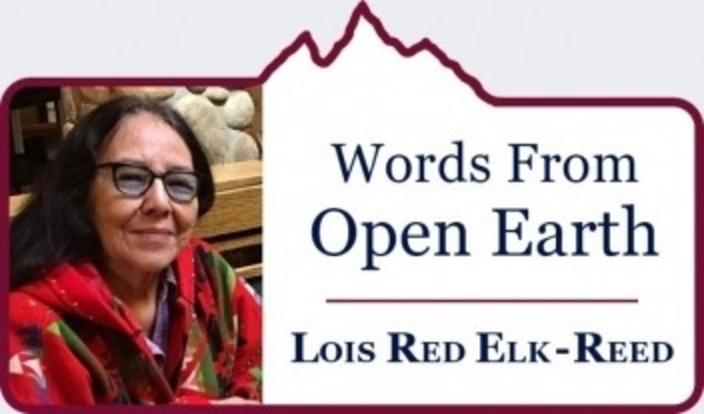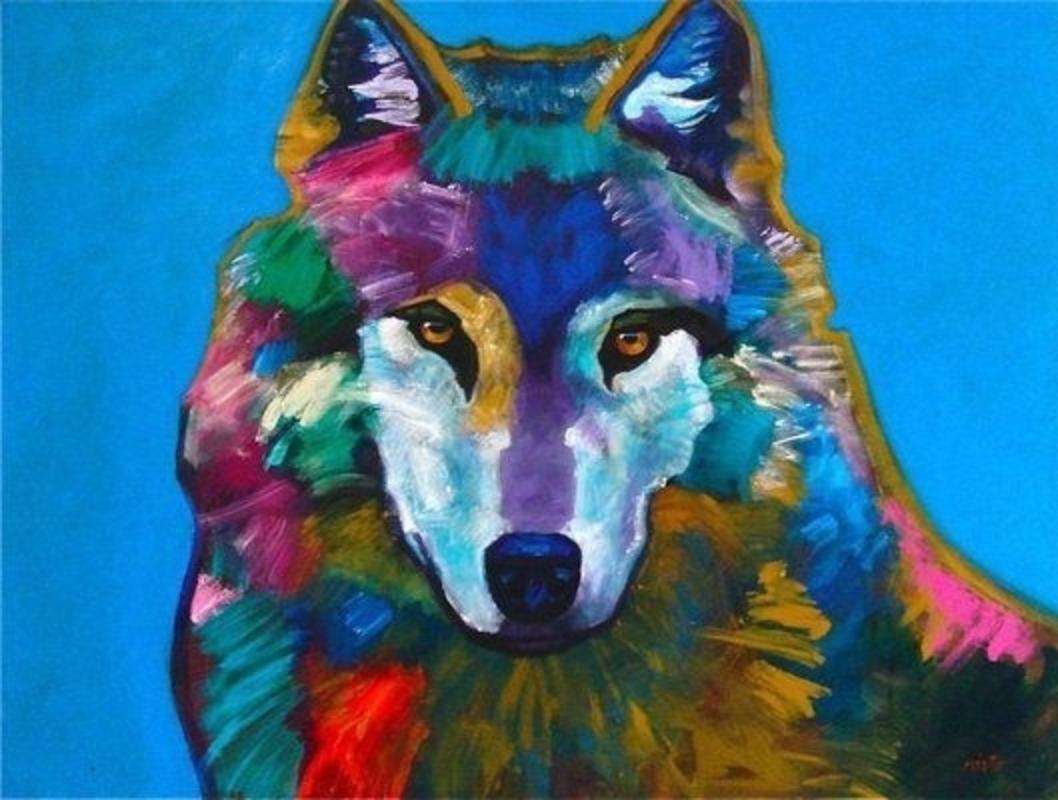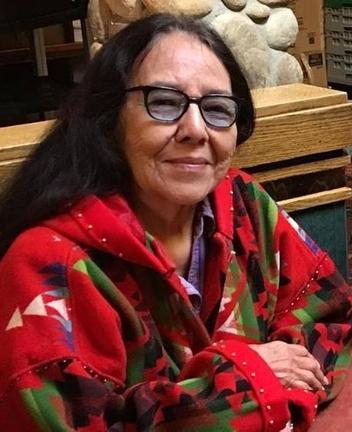Back to StoriesTwo Stories About Shung-mani-tu Tanka—The Lobo
January 11, 2019
Two Stories About Shung-mani-tu Tanka—The LoboLois Red Elk Tells Different Tales From "Little Red Riding Hood"
By now you know that Lois Red Elk is a polyglot. Raised speaking Dakota and Lakota by her elders, she took up English in school but has distinguished herself most by understanding the languages of the land, the other beings we share it with, of the wind, sky, and stars that possess their own animism, and of words that stand in for feelings, instincts and spiritual power, that can never adequately be described phonetically or spelled with letters of an alphabet.
Red Elk is distinguished as a free-form poet and her lyricism extends to all manner of narratives. Out on the prairie, the cold season has set in. "We are wintering very well along Mni Sose,” she says of her home in Wolf Point near the Mni Sose, the Missouri River. "Geese are still around and the river isn't frozen. I miss the snow, which is so important to clean the air and provide moisture for the land.”
Occasionally there are reports of wolves passing through, their presence sometimes confirmed by tracks in the frozen precipitation, sometimes scrubbed away by wind. “I have been reading so many stories about Shung-mani-tu Tanka, the Wolf, and their fight to survive,” she writes us. “They really are man's best friend, if man would take the time to know them.”
Indeed, to how many things can the same thoughts be applied? How often do we ascribe negative connotations to other people for whom we possess only a superficial understanding? Fresh into 2019, enjoy these paeans to Shung-mani-tu Tanka. —Mountain Journal eds
Once Upon a Wolf
for Grandma Louise
By Lois Red Elk
I lie looking at the log wall parallel to the length of the bed, and run my fingers along the frost between the logs. Quickly I feel for safe warmth coming from under the patchwork quilts covering my body. I wondered about the cold trying to come into the log house. The wind singing into the chimney sounded like an echo from the wolf I heard last summer. Maybe it was the wolf, trying to come into grandma’s warm house, talking to me through the gusts of wind. If I listened carefully, the high whine was like words slipping in our deep woods from branch to branch. Snow and frost covered the area where the wolf lived, but I knew he was there, under the rocks above the creek. Maybe if I shut my eyes real tight and dreamed real hard the wolf would come to the door and I would let him in so he could warm-up near the fire.
The meal was already set on the table when I got up. Grandma wasbusy making herself coffee. I sat daydreaming, the sound of the howlstill ringing in the story in my mind. Grandma asked how I slept and I told her I thought I heard a wolf and wanted to watch out the window.
It was a dream-like morning where a sparse light from the slow southern sun pried its way through the windows. Its angle cast uneven shadows across the room. She put a quilt around me as I sat spooning the oatmeal, and staring out the window hoping for some kind of recognizable image to appear among the bare chokecherry bushes in the distance, maybe like
a large shaggy wolf. Grandma sat looking at me and smiled. She said the wolves are taking care of their own family and are nice and warm in their thick furry coats.
After breakfast I got dressed and followed her around the house, still curious about the wolves. She said she would tell me a story later about a woman who got lost and the wolves saved her. Satisfied with that, I sat and helped her comb out her long braids, then we washed the dishes. Again a howling swept through the chimney and I thought about being lost and a friendly wolf finding me and keeping me warm. Grandma said she had a piece of tin and was going to ask grandpa to wrap it around the chimney so the snow wouldn’t float in.
As I wiped the bowls and spoons, grandpa came back from feeding thehorses. He said he saw a lot of deer tracks in the brush and was going to go out and get a deer. I told him he had to wrap some tin around the chimney because the snow was coming in. He laughed and said he’d take care of it after he came back. All afternoon, grandma sewed. She put patches on grandpa’s pants and patches on the blankets. I wondered how far grandpa had to go to get the deer and thought about the wolves. Maybe he would see them and let meknow what they were doing. When grandpa got back I was sound asleep and didn’t see the deer and porcupine he brought back.
When I woke up I smelled bread and soup and something sweet. Grandma had made a pie. I told her I had a dream about a wolf drinking water from the creek. She smiled and said grandpa saw a wolf by the creek, drinking and expected it to run away, but it just stopped, watched him then slowly trotted away. I was thinking that was my wolf, the one I heard that morning.
I shared that with grandma. Again she smiled, and said, it probably was.
©Lois Red Elk
A Wolf Encounter
By Lois Red Elk
I’ve always known that stories told to me as a child were examples to guide my adult life and I also knew a story would eventually leave the metaphor and become a life lesson. When I wrote, “Once Upon a Wolf” I had to follow up eventually by sharing the story of “The Woman Who Lived With Wolves, an ancient Dakota/Lakota story. I’m enclosing a brief version of that story here.
In my culture the Wolf represents the hunt and war. To enable a person to receive the knowledge of hunting and war preparation, a person had to dream of wolves. Our dream societies were numerous and the dreaming of wolf, the patron of warriors, introduced one into the Wolf Society. It became their ultimate supernatural power. Wolf Dreamers possessed an intuition for a sense of the nearness of danger, strategic planning and being successful in their defeat of the enemy. There was great ceremony in preparing for war which included prayer, offerings and communications. This ceremony invited the wolf spirit to the warrior.
During the time I was writing, "Once Upon a Wolf," I had several dreams of wolves. I was living and working in Cheyenne country at the time. One weekend, my husband and I were returning to our home in northern Montana. It was late and we were about 20 miles out of town when I sensed the presence of an animal ahead of us. I told my husband to slow down as deer often crossed the road in that area. Just as we started up a hill I saw movement on the east side of the highway then saw a large pair of eyes coming out of the coulee. As my husband slammed on his brakes a large wolf sauntered across the road in front of us. My husband looked at me with a renewed sense of belief and shook his head. I nodded and acknowledged the presence of Shung-mani-tu Tanka, a large male wolf. I whispered, “Wopila"—thank you. After the wolf crossed to the other side, it paused, turned slowly to look at us, then hurried West. It was a sight I will never forget.
I remember some words my father shared with me when I was trying to draw composites of the four-legged animals. I couldn’t capture the spirit that I wanted. Father said I needed to dream about it. This is a belief of our dream societies. Such a brilliant insight from our culture. I later dreamed of animals, many times as a matter of fact and was able to feel then see the images I wanted in my drawings. So with writing poems, I often dream of subjects, sense them, hear them and most importantly, the subjects give messages of their life. They speak with me, many times in my Dakota dialect.
The second time I saw the wolf, it was in the same area, about the same time of day. We were traveling home when I began thinking of the first encounter. I was peering out the car window then thought to roll the window down. The plains in this part of the country are rolling and covered with sage, wild grasses and little coulees. It is easy to miss seeing deer, porcupine or scurrying pheasants unless you live here and have cultivated a watchful eye. Again, I saw movement in the distance on the East side of the road. About 30 feet out, a shadow seemed to be running along side of the car. I strained to look and told my husband to slow down. I thought about the wolf then thought that this shadow was too large. Maybe it was a calf. As we descended down a little incline the shadow ran closer to the highway, dodging and leaping over the sage. When we reached the bottom of the little hill, I saw that the shadow was indeed a large wolf. I’m sure it was the same one we saw two weeks earlier.
At first the thought came that some will think this was unusual, but not for me. The wolf is the ancestor of the dog and in my culture we remember that. Growing up in a culture that is so connected to the spirit of other beings, I need to share with the readers the name, “Wamakaska.” It translates to “Beings of the earth.” This word is our name for animals – beings of the earth. We believe all animals, birds, water creatures and insects have spirit and were placed here for us to learn from and to share the earth. It is not unusual for the practitioners of these beliefs to know that connections can be made with the wamakaska through ceremony, spiritual practices and dreams. In my culture we are incouraged, from childhood, to speak with the wamakaska. ©Lois Red Elk






